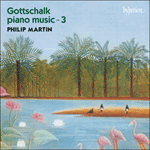
Welcome to Hyperion Records, an independent British classical label devoted to presenting high-quality recordings of music of all styles and from all periods from the twelfth century to the twenty-first.
Hyperion offers both CDs, and downloads in a number of formats. The site is also available in several languages.
Please use the dropdown buttons to set your preferred options, or use the checkbox to accept the defaults.
The work is a scintillating series of variations on da Silva’s beguiling theme with some passages of punishing left-hand leaps and bravura octave work, especially in the coda. Here, and in several other places, Gottschalk offers an ‘easier’ alternative; Philip Martin bravely opts for the more effective bars marked ‘Comme l’auteur le joue’, as did Guiomar Novaës in her pioneering recording of the work for Victor in 1927.
It is a curious coincidence that Gottschalk died on the day of the fourth anniversary of the death of the Brazilian anthem’s composer.
from notes by Jeremy Nicholas © 1997
L’œuvre est une étincelante série de variations sur le thème charmant de da Silva, avec quelques sauts exténuants, réalisés avec la main gauche, et quelques octaves, véritables morceaux de bravoure, surtout dans la coda. Là, comme ailleurs, Gottschalk propose une alternative «plus aisée», mais Philip Martin opte témérairement pour les mesures plus efficaces, marquées «comme l’auteur le joue», à l’instar de Guiomar Novaës dans l’enregistrement novateur réalisé pour Victor, en 1927.
Coïncidence curieuse, Gottschalk mourut le jour du quatrième anniversaire de la mort du compositeur de l’hymne brésilien.
extrait des notes rédigées par Jeremy Nicholas © 1997
Français: Hypérion
Dieses Werk setzt sich aus einer Reihe faszinierend-funkelnder Variationen über da Silvas hinreißendes Thema zusammen, einschließlich einiger Passagen mit teuflisch schwierigen Sprüngen der linken Hand und mit Bravour-Oktavläufen, insbesondere in der Coda. Gottschalk bietet hier, und auch an vielen anderen Stellen, eine „einfachere“ Alternative; Philip Martin entscheidet sich mutig für die wirkungsvolleren Takte mit der Anweisung „Comme l’auteur le joue“ („wie der Autor es spielt“), und auch Guiomar Novaës traf für ihre bahnbrechende Aufnahme des Werkes für Victor im Jahre 1927 dieselbe Entscheidung.
Es scheint ein merkwürdiger Zufall, daß Gottschalk genau am vierten Todestag des Komponisten der brasilianischen Hymne verstarb.
aus dem Begleittext von Jeremy Nicholas © 1997
Deutsch: Manuela Hübner
 Gottschalk: Piano Music, Vol. 3 Gottschalk: Piano Music, Vol. 3‘The pre-eminent Gottschalk interpreter of the 1980s and 1990s. Again the piano sound from the fastidious Hyperion team is absolutely flawless. Don't ... ‘Another distinguished addition to a most valuable cycle’ (Fanfare, USA)» More |
 Gottschalk: The Complete Solo Piano Music Gottschalk: The Complete Solo Piano MusicWith his idiomatic and graceful style, pianist Philip Martin has established himself as the foremost exponent of Gottschalk. The composer had a unique spontaneity and individuality which Martin’s performances bring vividly to the fore. The complet ...» More |

